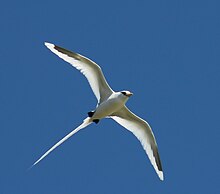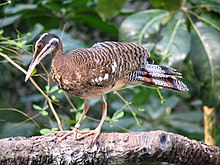Eurypygimorphae
| Eurypygimorphae Temporal range: Possible Maastrichtian record
| |
|---|---|

| |

| |
| Top: white-tailed tropicbird (Phaethontiformes) Bottom: sunbittern (Eurypygiformes) | |
| Scientific classification | |
| Domain: | Eukaryota |
| Kingdom: | Animalia |
| Phylum: | Chordata |
| Class: | Aves |
| Clade: | Phaethoquornithes |
| Clade: | Eurypygimorphae Fürbringer, 1888 |
| Orders | |
Eurypygimorphae or Phaethontimorphae is a clade of birds that contains the orders Phaethontiformes (tropicbirds) and Eurypygiformes (kagu and sunbittern) recovered by genome analysis.[2] The relationship was first identified in 2013 based on their nuclear genes.[3] This group was defined in the PhyloCode by George Sangster and colleagues in 2022 as "the least inclusive crown clade containing Phaethon aethereus, Eurypyga helias, and Rhynochetos jubatus".[4] Historically these birds were placed at different parts of the tree, with tropicbirds in Pelecaniformes and the kagu and sunbittern in Gruiformes. Some genetic analyses have placed the eurypygimorph taxa in the controversial and obsolete clade Metaves, with uncertain placement within that group.[5][6] More recent molecular studies support their grouping together in Eurypygimorphae, which is usually recovered as the sister taxon to Aequornithes within Ardeae.[2][7][8]
References
- ^ Mayr, G.; De Pietri, V. L.; Love, L.; Mannering, A.; Crouch, E.; Reid, C.; Scofield, R. P. (2023). "Partial skeleton from the Paleocene of New Zealand illuminates the early evolutionary history of the Phaethontiformes (tropicbirds)". Alcheringa: An Australasian Journal of Palaeontology. 47 (3): 315–326. Bibcode:2023Alch...47..315M. doi:10.1080/03115518.2023.2246528.
- ^ a b Jarvis, E.D.; et al. (2014). "Whole-genome analyses resolve early branches in the tree of life of modern birds". Science. 346 (6215): 1320–1331. Bibcode:2014Sci...346.1320J. doi:10.1126/science.1253451. PMC 4405904. PMID 25504713.
- ^ Yuri, Tamaki; Kimball, Rebecca; Harshman, John; et al. (2013). "Parsimony and Model-Based Analyses of Indels in Avian Nuclear Genes Reveal Congruent and Incongruent Phylogenetic Signals". Biology. 2 (1): 419–444. doi:10.3390/biology2010419. PMC 4009869. PMID 24832669.
- ^ Sangster, George; Braun, Edward L.; Johansson, Ulf S.; Kimball, Rebecca T.; Mayr, Gerald; Suh, Alexander (2022-01-01). "Phylogenetic definitions for 25 higher-level clade names of birds" (PDF). Avian Research. 13: 100027. Bibcode:2022AvRes..1300027S. doi:10.1016/j.avrs.2022.100027. ISSN 2053-7166.
- ^ Ericson, P. G.P; Anderson, C. L; Britton, T.; Elzanowski, A.; Johansson, U. S; Kallersjo, M.; Ohlson, J. I; Parsons, T. J; Zuccon, D.; Mayr, G. (2006). "Diversification of Neoaves: integration of molecular sequence data and fossils". Biology Letters. 2 (4): 543–547. doi:10.1098/rsbl.2006.0523. PMC 1834003. PMID 17148284.
- ^ Hackett, S. J.; Kimball, R. T.; Reddy, S.; et al. (2008). "A Phylogenomic Study of Birds Reveals Their Evolutionary History" (PDF). Science. 320 (5884): 1763–1768. Bibcode:2008Sci...320.1763H. doi:10.1126/science.1157704. PMID 18583609. S2CID 6472805.
- ^ Prum, R.O. et al. (2015) A comprehensive phylogeny of birds (Aves) using targeted next-generation DNA sequencing. Nature 526, 569–573.
- ^ Suh, Alexander (2016). "The phylogenomic forest of bird trees contains a hard polytomy at the root of Neoaves". Zoologica Scripta. 45: 50–62. doi:10.1111/zsc.12213. ISSN 0300-3256.